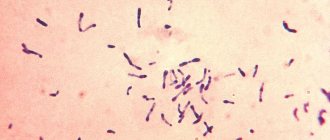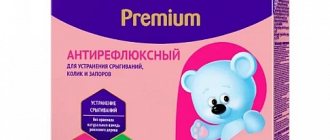Pharmacodynamics and pharmacokinetics
It should be noted that the ADS-M vaccination means: diphtheria-tetanus toxoid in small doses. It is also a variation of the DTP vaccine , but without the pertussis component.
The basis of the vaccine is a mixture of substances that have undergone special treatment. They do not cause severe toxic reactions or infectious diseases, but form an immunological reaction. It is this reaction that is the basis of the principle of action of this vaccination, thanks to which stable immunity to tetanus and diphtheria .
This vaccine is used for revaccination in adult patients and children aged 4-6 years who previously received the DPT vaccine. Therefore, in this case, the ADSM vaccination does not so much build immunity as maintain the level of antibodies at the required level.
Also, this drug is intended for children with intolerance to the pertussis component, which is contained in DTP and ADS vaccinations, for the purpose of emergency immunization, for example, according to epidemic indications.
What is ADSM vaccinated against?
The drug contains substances that produce the causative agents of tetanus and diphtheria. These antigens are purified and only then introduced into the body. After the injection, a protective reaction is triggered: antibodies to the infection begin to be produced, and immunity is formed. It will last for about 10 years, then you need to get a new vaccination.
If after vaccination a person gets sick with diphtheria or tetanus, he will tolerate them more easily. Children have a reduced risk of dying from infection.
Indications for ADSM:
- children over 7 years of age (or 4 years if the child has not been given ADCS);
- lack of early vaccinations with toxoid in adults;
- intolerance to the pertussis component in DPT;
- elderly age;
- contacts with patients with diphtheria, tetanus (emergency immunization);
- animal bite;
- gangrene;
- out-of-hospital abortion;
- home birth;
- tissue infection.
Indications for use
Vaccination with ADS-M for children over 6 years of age and adult patients is recommended as a prophylaxis against diphtheria and tetanus.
This vaccine is also indicated for adult patients over 18 years of age with:
- primary vaccination;
- carrying out systematic revaccination against diphtheria and tetanus. The vaccine contains a reduced dosage of diphtheria toxoid to reduce the risk of developing possible hypersensitivity reactions;
- the threat of tetanus due to injury.
Side effects
This drug is characterized by low reactogenicity, but the likelihood of adverse reactions should not be excluded.
It has been established that the side effects of vaccinations in adults and children can be general or local. They usually appear within 1-2 days from the moment of administration.
Local reactions include: redness, induration, loss of sensitivity and swelling at the site where the vaccine is given.
Common side effects are: fever , moodiness, lethargy, loss of appetite and digestion.
The appearance of such symptoms after vaccination is considered normal and does not require treatment, although the use of Ibuprofen or Paracetamol . Experts also recommend drinking plenty of fluids.
Severe complications of ADS-M vaccination occur infrequently, but they can manifest themselves as anaphylactic shock, Quincke's edema, encephalitis, and meningitis.
Introduction of ADSM vaccine: what to expect
Can there be negative reactions to the vaccine? Yes. As a rule, they appear in the first three days after the injection and, according to doctors, do not in any way affect the future health of the child. Yes, and they pass without a trace.
These include:
- temperature - it can be insignificant and rise to 37 C or quite high - up to 39 C, when the child needs an antipyretic. But in any case, it means only one thing: the immune system is working!
- local reaction - from slight redness - to compaction, swelling or bumps, which do not require additional care and go away on their own;
- diarrhea and vomiting;
- loss of appetite;
- moodiness, anxiety, inhibition of reactions;
- impaired mobility of the limbs due to severe pain in the injection area. In the first 2-3 days, you can fight it on your own by giving painkillers and applying ice to the location of the pain.
Later, you can no longer do without consulting a doctor.
Complications after ADSM in children are very rare. To be precise, in 2 cases out of 100 thousand.
They can appear in the form of:
- allergic rash, angioedema, anaphylactic shock and other severe allergic reactions;
- encephalitis;
- meningitis.
But you still shouldn’t be afraid of them, since such phenomena are nothing more than the result of non-compliance with contraindications to the ADSM vaccine.
Vaccine ADS-M instructions for use (Method and dosage)
As the instructions for the ADS-M vaccine show, it is administered intramuscularly. A suitable place for its insertion in children is the anterolateral part of the thigh, under the shoulder blade or in the shoulder area.
Revaccination of children is performed at 14-16 years of age and its effect lasts for 10 years.
After 10 years, adult patients are vaccinated with ADS-M, which will help maintain immunity at the required level against tetanus and diphtheria. Then revaccinations are carried out at 10-year intervals. However, no upper age limit has been established.
Vaccination calendar for children
Most children under 4-6 years old are recommended to receive DTP. After this, the result is maintained with ADSM. If the pertussis component is abandoned, the newborn is given injections with the vaccine without it at the ages of 3, 4.5 and 6 months. The interval is increased if the child has a negative reaction. A year later, another 1 dose is administered, which consolidates the effect.
Frequent vaccination is required, since the effect of ADSM on children is weak.
The following is the graph:
- 4-6 years - revaccination is carried out before starting school, where the risk of morbidity is increased;
- 14-16 years - new revaccination (R3), the period of 10 years is counted from the previous vaccination.
special instructions
Intravenous injection into the buttock is unacceptable, as this may damage the sciatic nerve or blood vessels.
Carrying out immunosuppressive treatment or having an immunodeficiency can reduce the intensity of the immune response to the vaccine. Therefore, it is necessary to complete the therapy or ensure complete safety for the patient. Vaccinations can be given to people with chronic immunodeficiency when a concomitant disease does not prevent the formation of even a small level of antibodies.
Contraindications to ADSM
Like other medications, the ADSM vaccine has its contraindications.
There are not many of them, however, it is imperative to pay attention to them, which is what pediatricians do when they conduct a short survey of the mother before vaccination. This:
- individual intolerance to components;
- the presence of all kinds of diseases;
- exacerbation of chronic ailments;
- immunodeficiency;
- an overly violent reaction to a previously administered ADSM vaccination.
Analogs
Level 4 ATC code matches:
Diphtheria-Tetanus toxoid
Tetanus toxoid
There is an imported vaccine Imovax D.T.Adult , which is better tolerated and does not lead to the development of unwanted reactions.
There are also monovalent vaccines , that is, separately for diphtheria - AD and tetanus - AS.
Difference between DTP and ADS-M
There are great similarities between DPT and ADS-M vaccinations. But DTP additionally contains a component that is directed against whooping cough.
ADS-M vaccination is recommended for adult patients and children over 4 years of age for vaccine administration or revaccination, since for this age a disease such as whooping cough is no longer dangerous.
However, in children under 4 years of age, everything is completely different - whooping cough is not only a dangerous disease, but can also be fatal. This disease can develop at lightning speed. And if an adult may have a prolonged cough, then in children a spasm of the respiratory muscles may occur, leading to a sudden stop in breathing. Only immediate resuscitation measures will help save life.
Description of ADSM vaccination
Adsorbed diphtheria-tetanus - this is what the decoding of this abbreviation looks like. The letter M at the end means “in small doses”: this distinguishes the ADSM vaccine from the ADS vaccine. The vaccination drug is available in the form of 1 ml ampoules with a yellow-white solution for injections. The active components are toxoids - substances that are produced by infectious agents. In addition to them, the ampoule contains preservatives. The composition of 0.5 ml (1 dose) of the drug ADSM looks like this:
- diphtheria toxoid – 5 units;
- tetanus – 5 units;
- formaldehyde – for adsorbing toxoids;
- thiomersal and aluminum hydroxide are preservatives.
Disposable syringes containing 1 dose of the drug are considered a safer form of release. It does not contain thiomersal, a mercury compound that is toxic to humans. This form is more expensive than ampoules, and the state does not buy it. For this reason, it is found only in private clinics. In municipalities, doctors use 1 ml ampoules for 2 procedures. The ADSM vaccine may have additional designations:
- R2 – for repeated vaccination (re-vaccination) in children 6-8 years old;
- R3 – for the third revaccination in adolescents 14-16 years old.
Monovalent versions of the drug - AD-m and AS-m - work only against tetanus or diphtheria. The amount of active substance in them is the same: 5 units per 0.5 ml. Children are vaccinated with such compounds from the age of 6 years.
Many doctors believe that it is not worth using AD-m or AS-m separately.
The toxoids in them are purified less well than in ADSM, and more preservatives are ingested in 2 injections.
How is it different from DTP?
The ADSM vaccine is bivalent because it contains 2 toxoids - against tetanus and diphtheria. The drug for DTP vaccination is polyvalent: it also contains an anti-whooping cough component. This disease is very dangerous for children under 4 years of age.
There is no need to revaccinate against it; immunity has already been formed, so only ADSM is given later.
Allergic reactions and severe complications to this composition develop less frequently, since the vaccine:
- safe for people who are intolerant to the whooping cough component;
- easier to accept by the body (DPT can give a negative reaction);
- has reduced doses of toxoid.
Reviews of the ADS-M vaccine
One of the most discussed topics on parenting and medical forums is vaccination. According to some parents, vaccinations are a necessity, and they find it strange that anyone would even doubt it. Others believe that vaccinations are dangerous to health and the body as a whole. Therefore, disputes about them can continue endlessly.
It should be noted that reviews of the ADS-M vaccine are quite common. They are largely related to the body’s reaction to vaccination. Patients often report experiencing unwanted symptoms after the procedure. For example, some are concerned about pain and an increase in temperature up to 38 degrees. In this case, the temperature rises especially often and usually occurs in the evening or the next day after vaccination. Sometimes this lasts for at least a week. In addition, muscle pain may occur.
You can also find reports where injections were given to patients after receiving wounds to prevent tetanus. As a result, lumps and skin irritations may appear.
Among all the discussions, questions arise: what does the ADS-M vaccination help against and what is it needed for? In addition, many adults do not know that after 14-16 years it needs to be given every 10 years, and for them this was a real discovery.
In most cases, side effects last 1-2 days. But it happens when it lasts longer. Then medical intervention and medication may be required. Of course, you should not abuse the use of tablets on your own, as this can further complicate the condition. It is best to consult a doctor immediately.
Emergency vaccination
What to do if emergency vaccination is required? “Unfortunately, there are situations when emergency vaccination against another virus is necessary or, depending on the endemic zone, other vaccines are given priority (for example, against tetanus, measles or tick-borne encephalitis), then in this case it is imperative to assess the risks from which of the two threats above you, and then make a choice, and then adjust the receipt of vaccinations depending on the recommendations described above,” says Evgenia Parshina.
If you can’t choose, and you still want to get vaccinated with both vaccines as soon as possible, then the action plan should be discussed with a vaccinologist, warns the immunologist. Routine vaccinations against influenza, chickenpox, etc. should be considered in advance, taking into account the required interval of 30 days, the doctor emphasizes.
You should not make independent decisions regarding the choice of drug, timing of vaccination, as well as the intervals between vaccination and revaccination. Self-medication is unacceptable; you need to consult with a specialist who has special scientific information and will give qualified recommendations.
There are contraindications, you must consult a specialist










